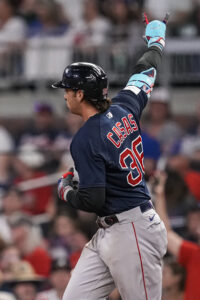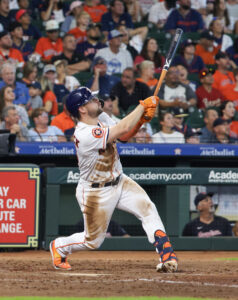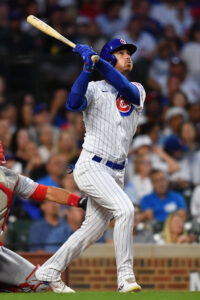We’ve reached the point of the season when prospect call-ups won’t expend their rookie status due to time spent on the roster. It’s still technically possible for such players to pass the plate appearance or innings pitched thresholds.
In any event, this marks an opportunity for teams to offer their young players time to acclimate in the Majors ahead of a Rookie of the Year bid in 2024. We saw similar with Corbin Carroll and Gunnar Henderson last season. Let’s cover a few such players along with others on the ascent.
Five Big Hype Prospects
Nolan Schanuel, 21, 1B, LAA (MLB)
14 PA, .250/.357/.250
Schanuel was summoned by a desperate Angels club to cover for the absence of C.J. Cron. The 2023 draftee has over twice as many walks as strikeouts in limited professional action. In a perfect world, he likely would have spent more time in the minors working on achieving higher-quality contact. There isn’t a spot on the Angels roster for both Cron and Schanuel. In other words, we can expect Schanuel to return to the minors if and when Cron recovers from his lower-back tightness. Until then, we’ll see if Schanuel can learn to complement his discipline and feel for contact with better lift and exit velocities.
Masyn Winn, 21, SS, STL (MLB)
(AAA) 498 PA, 18 HR, 17 SB, .288/.359/.474
A high-probability league-average shortstop with upside for more, Winn is now 11 plate appearances into his Major League career. The well-rounded shortstop makes up for a lack of carrying traits (besides his impressive throwing arm) with an equal lack of weaknesses. There’s only one knock against him: merely adequate exit velocities. Adequacy is hardly damning praise. For a 21-year-old to possess his skills and traits means he has countless ways to take the next step from acceptability to stardom. He could do it on defense, through feel for contact, burgeoning power, speed on the basepaths, or a little bit of everything.
Noelvi Marte, 21, 3B, CIN (MLB)
(AA/AAA) 389 PA, 11 HR, 18 SB, .281/.360/.460
Marte was one of the first prospects covered by this column last season. I noted a slight souring among evaluators who were beginning to see him as more of a core performer than a future star. His performance this season remains prime for disagreement. The surface level stats are good-not-great, and his peripherals are a mixed bag. He’s a tad prone to swinging strikes. Even so, he avoids strikeouts while showing plus discipline. He also produces exciting top-end exit velocities for a 21-year-old. Some scouts think he’s close to physically maxed out. Others see room for further growth.
Broad strokes, the outlook is similar to Winn albeit from a lesser defensive position. There are so many ways for Marte to find his way to star-caliber production. The floor resembles a Major League core performer.
Kyle Harrison, 22, SP, SFG (MLB)
(AAA) 65.2 IP, 14.39 K/9, 6.58 BB/9, 4.66 ERA
Harrison makes for one of the toughest evals in the minors. He has a feel for missing bats along with the repertoire of a high-ceilinged starting pitcher. He also happens to struggle with command and control. Of his 21 starts, Harrison reached five innings exactly once. He never faced 20 or more batters. The relief risk is ooey-gooey tangible, but the Giants have every incentive to give him more time in the rotation. Presently, Harrison is expected to join a unit consisting of Logan Webb and a handful of struggling veterans like Alex Cobb, Alex Wood, Sean Manaea, and Jakob Junis. The Giants will be playing bullpen games from here through the end of the season.
Ethan Salas, 17, C, SDP (AA)
(A/A+) 257 PA, 9 HR, 5 SB, .257/.335/.447
At the tender age of 17 years, 2 months, and 20 days, Salas finds himself in Double-A. This latest promotion is virtually unprecedented, made all the more so because Salas hit just .200/.243/.229 in 37 High-A plate appearances. It doesn’t require an active imagination to wonder what else is going on here. Perhaps the Padres Double-A affiliate has a desirable instructor or facilities. Maybe, like a baby bird, he imprinted on one of the other players the Padres promoted to Double-A yesterday. Could a long-term contract be in the offing?
In any event, Salas is now the youngest player to grace Double-A in recent memory. He’s considered a precocious receiver with the potential to become a quality hitter too.
Three More
Carson Williams, TBR (20): The Rays promoted Williams from High-A straight to Triple-A. The move allows for Junior Caminero’s (Double-A) development to remain unaffected. Williams is 1-for-13 with two walks and six strikeouts. He’s running a 22.2 percent swinging strike rate with poor exit velocities. Note the tiny sample.
Samuel Zavala, SDP (18): Though not quite on the Salas-track, Zavala earned a promotion to High-A yesterday after hitting .267/.420/.451 with 14 home runs and 20 steals in 459 Low-A plate appearances. He has issues adjusting to pitches in certain parts of the strike zone, especially up-and-away.
Paul Skenes, PIT (21): Earlier today, the Pirates announced Skenes would join the Double-A club, skipping High-A in the process. Whether this move is in preparation for a 2023 or 2024 debut, it won’t be long before we see Skenes grace a big league mound.
Did I miss a detail or nuance? DM me on Twitter @BaseballATeam to suggest corrections.



